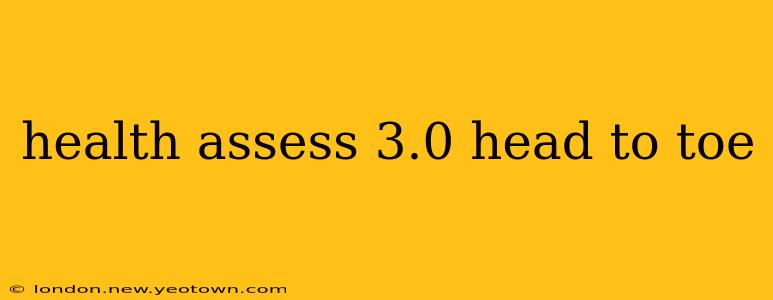The Comprehensive Health Assessment 3.0: A Head-to-Toe Journey
The human body is a marvel of intricate systems, a symphony of coordinated functions. Understanding its health requires a thorough assessment, and Health Assessment 3.0 takes this to a new level – a meticulous head-to-toe examination designed for a holistic understanding of well-being. This isn't just a checklist; it’s a journey of discovery, revealing subtle clues that can contribute to early diagnosis and preventative care.
This isn't your typical cursory check-up; Health Assessment 3.0 is about actively listening to your body's whispers, noticing the nuances, and understanding the interconnectedness of each system. Think of it as a detective story, where every observation is a clue leading to a greater understanding of your overall health.
Let's embark on this journey, exploring each stage of this comprehensive assessment:
1. General Appearance and Vital Signs:
Our investigation begins with a broad overview. We observe your overall appearance – posture, gait, level of alertness, and any immediate signs of distress. This initial impression sets the stage for a deeper dive. Next, we gather the vital signs: temperature, pulse, respiration rate, and blood pressure – the four cornerstones of assessing your body's fundamental functions. These vital numbers tell a silent story, indicating potential imbalances or underlying issues.
2. Neurological Assessment:
This crucial step explores the intricate workings of your nervous system. We assess your level of consciousness, mental status, cranial nerves, motor function, sensory perception, and reflexes. This intricate process helps detect any neurological deficits, from subtle cognitive changes to significant motor impairments. Imagine it as testing the electrical wiring of your body, ensuring each connection is functioning properly.
3. Head and Neck Assessment:
Next, we carefully examine your head and neck, assessing your hair, scalp, eyes, ears, nose, mouth, and throat. We check for any abnormalities – from subtle skin changes to irregularities in the oral cavity. This detailed inspection can reveal underlying issues often overlooked in less thorough assessments. Think of this as a detailed examination of the body's sensory command center.
4. Cardiovascular Assessment:
Here, we focus on the heart and circulatory system, assessing heart sounds, rhythm, and pulses in various locations. We’re listening for murmurs, irregularities, and other clues that might indicate underlying cardiovascular issues. This is a critical part of the assessment, as heart health plays a significant role in overall well-being.
5. Respiratory Assessment:
Next, we delve into the respiratory system, observing your breathing patterns, lung sounds, and chest expansion. This assessment helps detect any respiratory difficulties, including wheezing, rales, or other irregularities. The ability to breathe freely is essential, and a careful respiratory assessment is vital.
6. Gastrointestinal Assessment:
Now, we examine the gastrointestinal tract, assessing your abdomen for distension, tenderness, or other signs of discomfort. We also assess bowel sounds and inquire about bowel habits. This provides crucial insights into digestive health and potential issues.
7. Musculoskeletal Assessment:
This step examines your muscles, bones, and joints, assessing range of motion, strength, and any signs of pain or inflammation. We look for signs of injury, arthritis, or other musculoskeletal disorders. This aspect is crucial, particularly for those engaged in physically demanding activities.
8. Integumentary Assessment:
This is where we explore the largest organ – your skin. We meticulously examine your skin for lesions, rashes, wounds, and other skin abnormalities. We also evaluate skin turgor and overall hydration. The skin often provides valuable clues about underlying health conditions.
9. Psychosocial Assessment:
Health assessment isn't just about physical symptoms. Health Assessment 3.0 integrates a crucial psychosocial component, assessing your emotional and mental state. This includes evaluating your mood, stress levels, social support, and overall well-being. A holistic approach acknowledges the critical interconnectedness of mind and body.
What are the different types of health assessments?
Health assessments vary depending on the context and purpose. There are routine check-ups, specialized assessments for specific conditions (e.g., cardiac assessments, neurological assessments), and emergency assessments. The type of assessment determines the level of detail and specific areas of focus.
How long does a comprehensive health assessment take?
The duration varies greatly, depending on the individual's health status and the specifics of the assessment. A thorough head-to-toe assessment can range from 30 minutes to over an hour.
What should I expect during a head-to-toe assessment?
Expect a thorough examination, including the aspects detailed above. The clinician will ask questions about your medical history, lifestyle, and any symptoms you're experiencing. This collaborative process aims to gather a complete picture of your health.
Health Assessment 3.0 offers a more comprehensive approach, incorporating new technologies and a deeper understanding of the interconnectedness of bodily systems. It's a powerful tool in preventative care, early disease detection, and promoting a holistic approach to overall well-being. It’s a journey of self-discovery, ultimately leading to a more informed and empowered understanding of your health.

